Green Ribbon Schools
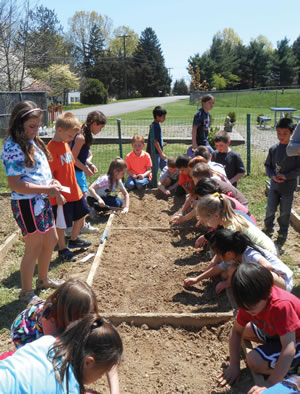
PHOTO COURTESY OF THREE BRIDGES ELEMENTARY SCHOOL
“We started small and built from there.” That’s in part how Principal Kristen Higgins of Three Bridges Elementary School in New Jersey describes the launch of her school’s environmental and wellness program. The approach must have worked, because Three Bridges’ program is now one of the 57 schools and districts in 27 states named recently as a Green Ribbon Schools award honoree by the U.S. Department of Education (ED).
Three Bridges, had to creatively “make things happen on a shoe string,” Higgins points out, and find effective ways to engage and energize youngsters at the pre-K through third grade school. Three Bridges forged ahead with a set of initiatives that include partnering with engineers, parents, a local organic farmer, area high school students and Girl Scouts on sustainability, green and wellness programs; recycling programs with active student participation; and weaving green into the curriculum with themed contests. Overall, “it was a hugely cooperative effort,” says Higgins, citing participation by a wide range of faculty, staff as well as youngsters.
School Planning & Management recently walked through Three Bridges with Don Thornton, Facilities manager for the school’s Readington Township District. Thornton showed various features, including gardens in a tiny courtyard and another garden tilled by youngsters on school grounds. The impression: a school that proactively does what it can to instill green awareness in its students and make a difference. Of course, there are limits to what any school could do, but the doing is the thing. “It’s not about perfection,” Thornton says.
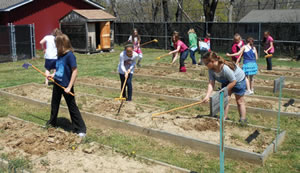
PHOTO COURTESY OF THREE BRIDGES ELEMENTARY SCHOOL
Hoe, hoe, hoe. The school garden is just one of the effective ways used to engage and energize youngsters at Three Bridges Elementary School. The pre-K through third grade school forged ahead with a set of initiatives that include partnering with engineers, parents, a local organic farmer, area high school students and Girl Scouts on sustainability, green and wellness programs; recycling programs with active student participation; and weaving green into the curriculum with themed contests.
Green Ribbon honorees such as Three Bridges emerged from a process in which state education agencies nominated schools and districts — 2014 is the second year of the program. The honorees were recognized for efforts that exemplify Green Ribbon’s three so-called “pillars”: green facilities, wellness programs and environmental education.
Announcing the honorees in April, Arne Duncan, ED secretary, said each is “demonstrating ways schools can simultaneously cut costs, improve health and engage students in hands-on learning.” Mike Boots, acting chair of the White House Council on Environmental Quality, suggested that “schools all over the country can look to today’s honorees as models” along those lines.
The honorees have too many notable programs and vibrant green activities to list here, but among those described in a ED highlights report are geothermal wells; photovoltaic energy systems; a facilities improvement plan that analyzed and shared energy consumption data in order to change behaviors; and a partnership with local experts, including a utility company, to evaluate school buildings for energy-saving retrofits.
There are proactive green teams; classes in nature-oriented service learning and green design and building technologies; a regional competition to design, build and race electric-powered go-carts; and a student-led movement to change behaviors and adjust an HVAC system to boost energy efficiency.
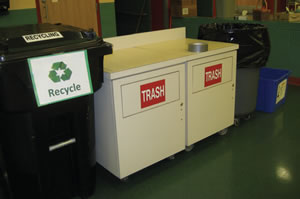
PHOTO BY SCOTT BERMAN
In terms of wellness, there are school gardens generating produce that students eat or donate to local causes; a variety of exercise activities; initiatives to encourage biking and walking instead of driving; among many others.
As the proactive program at Three Bridges indicates, the Green Ribbon program can recognize measures that are simple but effective. In other words, it doesn’t necessarily take a LEED-certified building to make a difference, although it helps: 13 of the honorees have such facilities. In other leading factors, the lion’s share, 43, of the awardees have on-site renewable energy systems, and 14 have Environmental Protection Agency Energy Star facilities. One Energy Star partner honoree, Greendale School District in Wisconsin, reported energy savings of $200,000 over a five-year period.
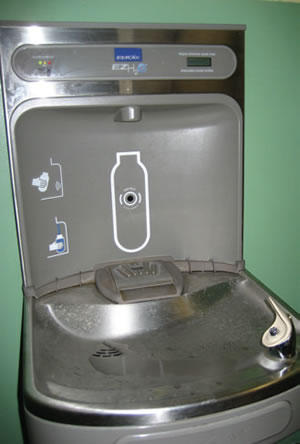
PHOTO BY SCOTT BERMAN
Fill’er up. One of the green elements is a water bottle filling station with a digital display that tallies the number of disposable water bottles that the filling station saves. The information gives meaning to the students’ usage of the fountain and can be incorporated into their curriculum.
Also among the standouts are the Boulder Valley School District in Colorado and Carmel High School in Indiana. At Boulder Valley, officials implemented a sustainable management system that coordinated long-standing environmental efforts throughout the district, which have cut energy use by 18 percent in the past four years and water consumption by 34 percent since 2008. There are solar systems, environmental lessons in the curriculum, indoor air quality measures and healthy food service events. Carmel High’s efforts includes green team of faculty, staff, students and parents, classes in outdoor facilities, green cleaning of schools, an environmentally friendly bus maintenance program, and a microgrant award program for students who implement green projects, such as providing water-saving showerheads to local facilities and energyefficient light bulbs to homes.
The Boulder Valley district’s efforts exemplify the adage that nothing worthwhile is easy. The district’s program is site-based managed, points out district Sustainability Coordinator Ghita Carroll, and with more than 50 schools, there are many things to consider, and limits on what the district can mandate. Often, it comes down to recommendations instead of mandates — a balance between efficiency and personal choice.
There are other things that districts may have to balance, Carroll points out, including:
- Sourcing green building materials that cannot be found locally, thus making for a delivery with larger carbon footprint.
- Making tough choices. Difficult budget environments can mean that districts may have to choose materials or equipment less expensive and not as green as alternatives.
- Going with newer, greener materials or more traditional ones that have stood the test of time. For example, tar roofs, which Carroll describes as “not the latest and greatest in terms of green, but they stand the test of time.” Alternatives may not be as robust.
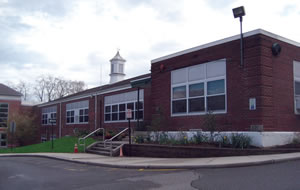
PHOTO BY SCOTT BERMAN
Ribbon winner. Three Bridges Elementary School, in New Jersey, is one of the schools nationally recognized recently by the U.S. Department of Education as a Green Ribbon School. The reason for the distinction is the school’s efforts regarding green facilities, wellness programs and environmental education.
Such hurdles can be cleared, yet there is no finish line, per se. Carmel High School’s Joe Schaller, assistant principal of operations, puts it this way: While it’s gratifying to be recognized with the award, the school’s efforts “are still a work in progress, and we’re always looking to make improvements.”
And such effort can pay dividends for years to come. As Secretary Duncan pointed out in the announcement: proactive green programs, among other important things, “engage students with hands-on learning that prepares them with the thinking skills necessary to be successful in college and careers.”
A crucial element of a successful effort on any scale is participation by as many stakeholders, of all ages, as possible. As Three Bridges’ Higgins adds of her school’s Green Ribbon program: “Everybody in the building has a piece of its application.”
Some tips about greening up a school or district:
- “Start small. Involve the children. Make sure policies and procedures in place are being followed and build from there,” as Kristen Higgins of Three Bridges says.
- Be organized. Set goals, benchmarks, and create a plan and a policy to guide and continue your work over time, according to Boulder Valley’s Ghita Carroll. One approach: have broad-based advisory groups each focusing on specific areas such as transportation, building materials, buildings, and education.
- Start with small steps. Have programs that build upon green activities in your schools that “students and facility are passionate about,” Carroll suggests.
Going through a process like completing the Green Ribbon application and others can itself be a helpful tool, says Carmel High School’s Joe Schaller. Rounding up, assessing and describing each and every green activity in your school or district helps to organize, evaluate and amplify those activities.
“Don’t be intimidated by the (Green Ribbon) application,” adds the Readington district’s Don Thornton, “Instead, do the things you can do and do them well.”
This article originally appeared in the issue of .